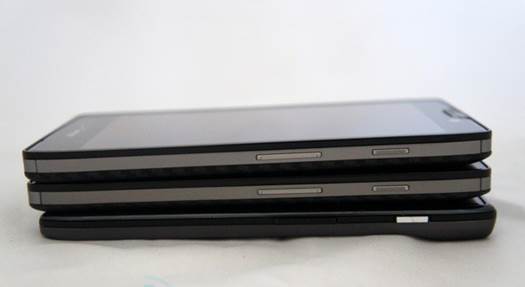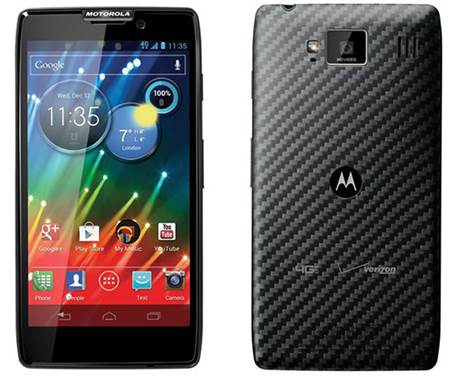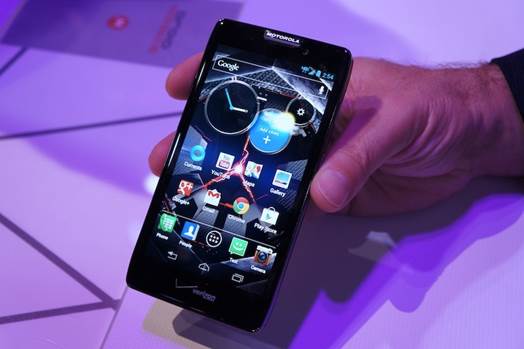Software
In addition to the short diversion around
the time of the Bionic, Motorola has significantly improved its custom UX with
each and every release. In our opinion, they have stripped away the layers and
moved closer and even closer to stock Android. This is the similar and small tweaked
Ice Cream Sandwich interface (4.0.4) that we have seen on the Atrix HD and the
RAZR M. Swiping to the right from the home screen reveals the quick settings menu,
which set the switches for WiFi, GPS, Bluetooth and other common used options
within easy reach. Swiping to the left allows you to navigate the home screen,
which can range from 1 to 7. If you have reached the end of the road,
continuing to the right presents you with a screen providing the ability to add
new "page" or manage your existing ones. This gives you the
opportunity to not only add or delete, but also reorder pages. You can also use
the templates, pre-populated with gadgets and shortcut, while adding new home
screen, though the choice is a bit paltry with only a media and office theme
offered out of the box. We can only imagine that things get better once Jelly
Bean update was released later.

RAZR
MAXX HD and RAZR HD software
There are a few other small changes to the standard
UX, including a favorites tab in the app tray, which seems a bit redundant with
the existence of home screens. However, we appreciate the 4-way unlock screen
which puts not just the camera, but also text messages and the dialer with only
a quick swipe away. We are also pleased to see the return of the vibrate
shortcut - a nifty features ripped by the wayside in the post-Gingerbread era.
A more subtle change is the notification pull-down, which no longer hides the
status bar.
Unfortunately, there is a lot of onboard
software here and none is removable. In addition to the usual glut of
Verizon-branded apps, Kindle, Color, NFL Mobile, Modern Combat 3, Real Racing
2, and Slacker Radio all come preinstalled. It's not as heavy as the pile of
applications that crammed into the RAZR M but we would prefer if there were no
third-party applications on the phone when taking it out of the box. We are
adults, who are capable of deciding which apps we want and which we do not
want, and until the carriers learn to leave well, their relationship with
customers is going to be continuous.
Wrap-up

The
RAZR HD and RAZR MAXX HD choose where their predecessors left off and resolve
every concern you might have had with the original model.
If there was an award for "Most Innovative
Phone", we would give it to the RAZR HD. With the Droid RAZR was released
2012, Motorola began to reconnect with its legacy of producing cutting-edge, advanced
hardware. It was far from perfect, but it certainly put the company on the
right track. The RAZR HD and RAZR MAXX HD choose where their predecessors left off
and resolve every concern you might have had with the original model. Most
significantly, the screen has gone from a 4.3-inch qHD panel to a 4.7-inch HD
one without changing the physical dimensions of the device. The manufacturer
has sacrificed style in the name of functionality, but has somehow success in
making a high-end device, which feels more like a luxury item. The truth is,
beside the battery life, specs are not the problem here. Clearly, NFC and fast
dual-core processor are good, but as we have said before, the RAZR is all about
the materials. This isn’t about the 1GB of RAM or the 8-megapixel camera; it’s
about the sheath of Kevlar, the face of glass and the heart of aluminum. The
entire device is protected with a water-repellent coating to safeguard your
investment.
If you can overcome the brick-like
construction, you will find that the newest RAZRs are of course worthy competitors
for your smartphone dollar. That's especially true if you are tired of
countless powerhouses that flood the market. Both provide adequate performance
with impressive battery life. In fact, the battery life is hardly run out of in
1 day. The only question remaining is, are these devices value for money? To
tell the truth, the MAXX would be an attractive product at $199 than it is at
$299. The 32GB of storage and extra 3 hours of battery life does not seem to
ensure the $100 premium it demands over the 16GB RAZR HD. And its $299 price is
a tough price to swallow for any phone. However, both have their own positions
in the battle of the high-end devices of Verizon with Galaxy S III and iPhone
5. And things will only be better when they’re upgraded to Jelly Bean later
this 2012.
Technical specs
Droid
RAZR HD
General
·
Type: Smartphone
·
Operating system: Android (Ice Cream Sandwich
[4.0])
·
Style: Bar
·
Antenna: Internal
Input
·
Input type: Touchscreen (capacitive [finger])
·
Predictive text: Yes
Power
·
Talk time: 3G (up to 24 hours)
·
Battery life: Li-ion (2500 mAh capacity)
Camera
·
Camera: 8 megapixels
·
Camera features: Records video, Auto focus,
Flash (LED), Contact pictures
Display
·
Screen size: 4.7 inches
·
Screen resolution: 1,280x720
·
Pixel density: 326 PPI
·
Screen type: LCD (Active, Color, Backlit)
Hardware
·
CPU: 1.5 GHz
·
CPU cores: Dual-core
·
RAM: 1 GB
·
USB: 2.0 (Micro-USB port, USB charging)
Storage
·
Internal memory: 12 GB
·
Memory card: microSD (microSDHC)
Size and price
·
Dimensions: (H x W x D): 5.19x2.67x0.33 inches
·
Price: $99

Droid
RAZR HD
Droid RAZR MAXX HD
General
·
Type: Smartphone
·
Operating system: Android (Jelly Bean [4.1])
·
Style: Bar
·
Antenna: Internal
Input
·
Input type: Touchscreen (capacitive [finger])
Power
·
Talk time: 3G (up to 32 hours)
·
Battery life: Li-ion (3,300 mAh capacity)
Camera
·
Camera: 8 megapixels
·
Camera features: Records video , Flash (LED),
Contact pictures
·
Secondary camera: Yes
Display
·
Screen size: 4.7 inches
·
Screen type: LCD (Active, Color, Backlit)
Hardware
·
CPU: 1.5 GHz
·
CPU cores: Dual-core
·
RAM: 1 GB
Storage
·
Internal memory: 32 GB
·
Memory card: microSD (microSDHC)
Size and price
·
Dimensions: (H x W x D): 5.19x2.67x0.33 inches
·
Price: $199

Droid
RAZR MAXX HD